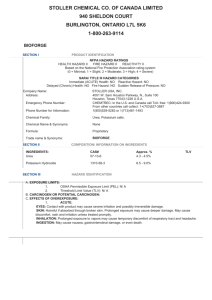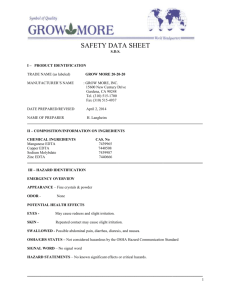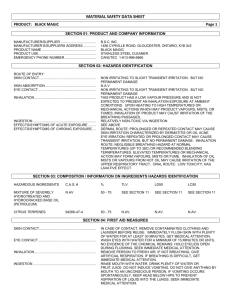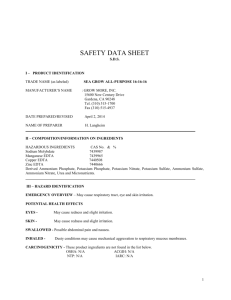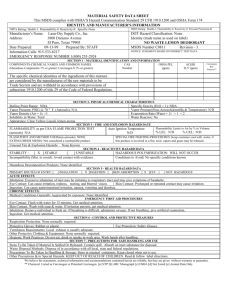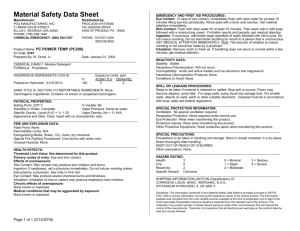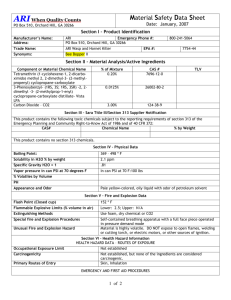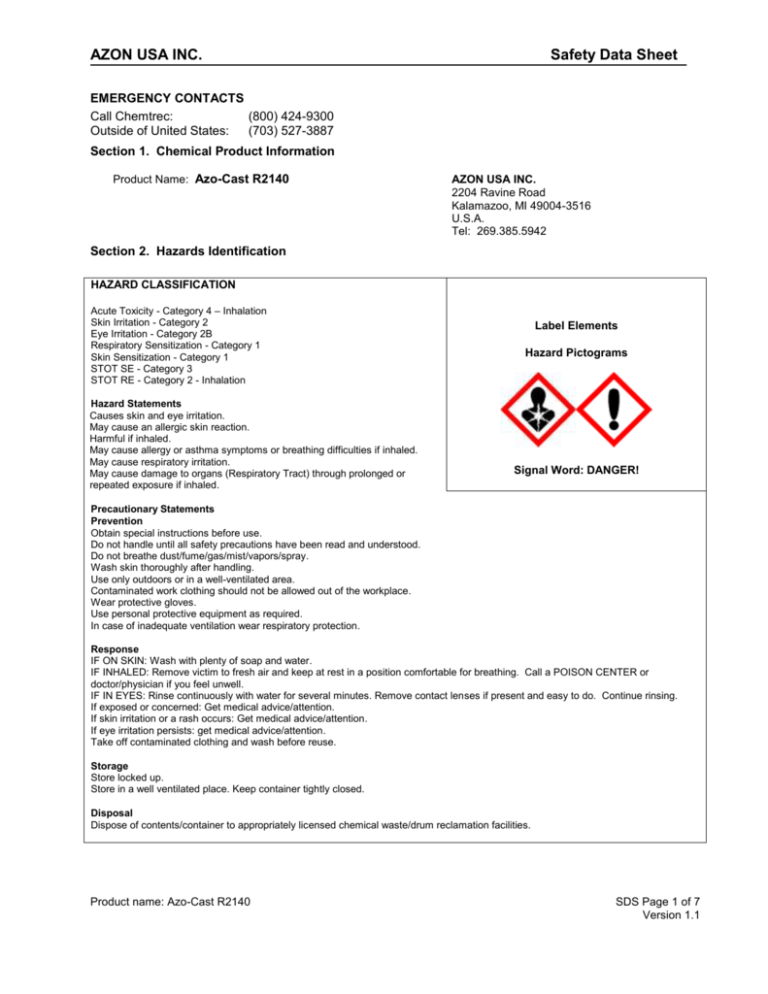
AZON USA INC.
Safety Data Sheet
EMERGENCY CONTACTS
Call Chemtrec:
(800) 424-9300
Outside of United States:
(703) 527-3887
Section 1. Chemical Product Information
Product Name: Azo-Cast R2140
AZON USA INC.
2204 Ravine Road
Kalamazoo, MI 49004-3516
U.S.A.
Tel: 269.385.5942
Section 2. Hazards Identification
HAZARD CLASSIFICATION
Acute Toxicity - Category 4 – Inhalation
Skin Irritation - Category 2
Eye Irritation - Category 2B
Respiratory Sensitization - Category 1
Skin Sensitization - Category 1
STOT SE - Category 3
STOT RE - Category 2 - Inhalation
Hazard Statements
Causes skin and eye irritation.
May cause an allergic skin reaction.
Harmful if inhaled.
May cause allergy or asthma symptoms or breathing difficulties if inhaled.
May cause respiratory irritation.
May cause damage to organs (Respiratory Tract) through prolonged or
repeated exposure if inhaled.
Label Elements
Hazard Pictograms
Signal Word: DANGER!
Precautionary Statements
Prevention
Obtain special instructions before use.
Do not handle until all safety precautions have been read and understood.
Do not breathe dust/fume/gas/mist/vapors/spray.
Wash skin thoroughly after handling.
Use only outdoors or in a well-ventilated area.
Contaminated work clothing should not be allowed out of the workplace.
Wear protective gloves.
Use personal protective equipment as required.
In case of inadequate ventilation wear respiratory protection.
Response
IF ON SKIN: Wash with plenty of soap and water.
IF INHALED: Remove victim to fresh air and keep at rest in a position comfortable for breathing. Call a POISON CENTER or
doctor/physician if you feel unwell.
IF IN EYES: Rinse continuously with water for several minutes. Remove contact lenses if present and easy to do. Continue rinsing.
If exposed or concerned: Get medical advice/attention.
If skin irritation or a rash occurs: Get medical advice/attention.
If eye irritation persists: get medical advice/attention.
Take off contaminated clothing and wash before reuse.
Storage
Store locked up.
Store in a well ventilated place. Keep container tightly closed.
Disposal
Dispose of contents/container to appropriately licensed chemical waste/drum reclamation facilities.
Product name: Azo-Cast R2140
SDS Page 1 of 7
Version 1.1
AZON USA INC.
Safety Data Sheet
Section 3. Composition/Information on Ingredients
Synonyms: MDI Prepolymer
Component
CAS Number
Concentration
Polymeric Diphenylmethane Diisocyanate
9016-87-9
<70%
Polyether Glycol
251-90-06-1
<50
Section 4. First Aid Measures
First Aid for Eyes:
Flush with plenty of water, preferably lukewarm for at least 15 minutes, holding eyelids open
all the time. Get medical attention.
First Aid for Skin:
Remove contaminated clothing. Wash affected skin thoroughly with soap and water. Wash
contaminated clothing thoroughly before reuse. For severe exposures, get under safety
shower and begin rinsing. Seek medical attention if irritation develops or persists after the
area is washed.
First Aid for Inhalation:
Move to an area free from risk of further exposure. Obtain medical attention. Administer
oxygen or artificial respiration as needed. Asthmatic-type symptoms may develop and may
be immediate or delayed up to several hours. Extreme asthmatic reactions can be life
threatening.
First Aid For Ingestion:
DO NOT INDUCE VOMITING. Wash mouth out with water. DO NOT GIVE ANYTHING BY
MOUTH TO AN UNCONSCIOUS PERSON. Consult physician.
Note To Physician:
EYES- Stain for evidence of corneal injury. If cornea is burned, instill antibiotic/steroid as
needed. Workplace vapors could produce reversible corneal epithelial edema impairing
vision. SKIN-This compound is a skin sensitizer. Treat symptomatically as for contact
dermatitis or thermal burns. INGESTION- Treat symptomatically. There is no specific
antidote. Inducing vomiting is contraindicated because of the irritating nature of this
compound. RESPIRATORY- Treatment is essentially symptomatic. An individual having a
dermal or pulmonary sensitization reaction to this material should be removed from exposure
to any diisocyanate.
Section 5. Fire Fighting Measures
Flash Point:
390°F (198.8°C)
Extinguishing Media:
Dry Chemical, CO2, chemical foam, water spray
Special Instructions:
Firefighters should wear NFPA compliant structural firefighting protective equipment, including
self-contained breathing apparatus and NFPA compliant helmet, hood, boots and gloves.
Avoid contact with product. Decontaminate equipment and protective clothing prior to reuse.
During a fire, isocyanate vapors and other irritating, highly toxic gases may be generated by
thermal decomposition or combustion. Exposure to heated diisocyanate can be extremely
dangerous.
Unusual Hazards:
Closed container may forcibly rupture under extreme heat or when contents are contaminated
with water (CO2 formed). Use cold-water spray to cool fire-exposed containers to minimize
the risk of rupture. Large fires can be extinguished with large volumes of water applied from a
safe distance, since reaction between water and hot diisocyanate can be vigorous.
Product name: Azo-Cast R2140
SDS Page 2 of 7
Version 1.1
AZON USA INC.
Safety Data Sheet
Section 6. Accidental Release Measures
Evacuate non-emergency personnel. Isolate the area and prevent access. Remove ignition sources. Notify
management. Put on protective equipment. Control source of the leak. Ventilate area. Contain the spill to prevent
spread into drains, sewers, water supplies, or soil. Major spill or leak (Standing liquid); released material may be pumped
into closed, but not sealed, metal container for disposal. Process can generate heat. Minor spill or leak (Wet surface):
cover spill area with suitable absorbent material (Kitty Litter Oil Dry). Saturate absorbent material with nuetralization
solution and mix. Wait 15 minutes. Collect material in open-head metal containers. Repeat application of
decontamination solution, with scrubbing, followed by absorbent until the surface is decontaminated. Check for residual
surface contamination. Swype® test kits have been used for this purpose. Apply lid loosely and allow containers to vent
for 72 hours to let carbon dioxide (CO2) escape. Decontamination: mixture of water (80%) with non-ionic surfactant
Tergitol® TMN-10 (20%), or; water (90%), concentrated ammonia (3-8%) and detergent (2%). Notify CHEMTREC (800424-9300) for releases of this product during the course of distribution.
Section 7. Handling and Storage
Storage Temperature:
64 °F (18 °C) / 86 °F (30 °C)
Handling/Storage Precautions: Do not breathe vapors, mists, or dusts. Use adequate ventilation to keep airborne
isocyanate levels below the exposure limits. Wear respiratory protection if material is heated sprayed, used in a confined
space, or if the exposure limit is exceeded. Warning properties (irritation of the eyes, nose and throat or odor) are not
adequate to prevent chronic overexposure from inhalation. This material can produce asthmatic sensitization upon either
single inhalation exposure to a relatively high concentration or upon repeated inhalation exposures to lower
concentrations. Employees with lung or breathing problems or prior allergic reactions to isocyanates must not be
exposed to vapor or spray mist. Avoid contact with skin and eyes. Wear appropriate eye and skin protection. Wash
thoroughly after handling. Do not breathe smoke and gases created by overheating or burning this material.
Decomposition products can be highly toxic and irritating. Store in tightly closed containers to prevent moisture
contamination. Do not seal if contamination is suspected. Employee education and training in the safe use and handling
of this compound are required under the OSHA Hazard Communication Standard 29 CFR 1910.1200.
Section 8. Personal Protection
Exposure Limits
ACGIH:
OSHA:
.005 ppm TWA .051 mg/m3
.02 ppm Ceiling .20 mg/m3 Ceiling
Eye Protection:
When directly handling liquid product, eye protection is required. Examples of eye protection
include a chemical safety goggle, or chemical safety goggle in combination with a full face
shield when there is a greater risk of splash.
Skin/Body Protection:
Avoid all skin contact. Depending on the conditions of use, cover as much of the exposed
skin area as possible with appropriate clothing to prevent skin contact. Gloves should be
worn. Nitrile rubber showed excellent resistance. Butyl rubber, neoprene and PVC are also
effective.
Ventilation:
Local exhaust should be used to maintain levels below the TLV whenever MDI is heated,
sprayed or aerosolized. Standard reference sources regarding industrial ventilation (i.e.,
ACGIH Industrial Ventilation) should be consulted for guidance about adequate ventilation.
To ensure that published limits have not been exceeded, monitoring for airborne diisocyanate
should become part of the overall employee exposure characterization program.
Respirator Requirements: Airborne MDI concentrations greater than the ACGIH TLV-TWA (TLV) or OSHA PEL-C (PEL)
can occur in inadequately ventilated environments when MDI is sprayed, aerosolized, or
heated. In such cases, respiratory protection must be worn. The type of respiratory protection
selected must comply with the requirements set forth in OSHA’s Respiratory Protection
Standard (29 CFR 1910.134). The type of respiratory protection available includes (1) an
atmosphere-supplying respirator such as a self-contained breathing apparatus (SCBA) or a
supplied air respirator (SAR) in the positive pressure or continuous flow mode, or (2) an airpurifying respirator (APR). If an APR is selected then (a) the cartridge must be equipped with
an end-of-service life indicator (ESLI) certified by NIOSH, or (b) a change out schedule based
Product name: Azo-Cast R2140
SDS Page 3 of 7
Version 1.1
AZON USA INC.
Safety Data Sheet
Section 8. Personal Protection (Cont.)
on information or data that will ensure that the cartridges are changed out before the end of
their service life, must be developed and implemented. The basis for the change out schedule
must be described in a written respirator program. Further, if an APR is selected, the airborne
diisocyanate concentration must be no greater than 10 times the TLV or PEL. The
recommended APR cartridge is an organic vapor/particulate filter combination cartridge
(OV/P100).
Medical Surveillance:
All applicants who are assigned to an isocyanate work area should undergo a pre-placement
medical evaluation. A history of eczema or respiratory allergies such as hay fever, are
possible reasons for medical exclusion from isocyanate areas. Applicants who have a history
of adult asthma should be restricted from work with isocyanates. Applicants with a history of
prior isocyanate sensitization should be excluded from further work with isocyanates. A
comprehensive annual medical surveillance program should be instituted for all employees
who are potentially exposed to diisocyanates. Once a worker has been diagnosed as
sensitized to any isocyanate, no further exposure can be permitted.
Section 9. Physical and Chemical Properties
Physical form:
Color:
Odor:
Boiling point:
Melting/Freezing point:
Solubility in water:
Specific gravity:
Bulk density:
Flash point:
Vapor pressure:
Liquid
Dark Brown to Black
Slightly musty odor
Approximately 406 °F (208 °C)
<32 °F (<0 °C) for the active ingredient
Insoluble- Reacts slowly with water to liberate CO2 gas.
1.24 @ 77 °F (25 °C)
10.3 lbs/gal.
390 °F (198.89 °C) (Pensky-Martens Closed-Cup (ASTM D-93))
<0.0001 mm Hg @ 77 °F (25 °C)
Section 10. Stability and Reactivity
Hazardous Reactions:
Contact with moisture, other materials that react with isocyanates, or temperatures above 350
°F (177 °C), may cause polymerization.
Material to Avoid:
Water, amines, strong bases, alcohols, copper alloys, aluminum.
Decomposition Product:
By high heat and fire: carbon monoxide, oxides of nitrogen , hydrogen cyanide, carbon
dioxide, dense black smoke, isocyanate, isocyanic acid, other undetermined compounds.
Section 11. Toxicological Information
Toxicity data based on polymeric MDI
Acute Toxicity:
Oral LD50- Greater than 2,000 mg/kg (Rat Male/Female)
Skin Irritation:
Slightly irritating (Rabbit)
Inhalation LC50:
490 mg/m3, vapor, 4 h (Rat)
Repeated Dose Toxicity:
90 days inhalation: NOAEL: 1 mg/m3, (Rat Male/Female, 6 hrs/day 5 days/week)
Irritation to lungs and nasal cavity.
2 years inhalation: NOAEL: 0.2 mg/m3, (Rat Male/Female, 6 hrs/day 5 days/week)
Irritation to lungs and nasal cavity.
Mutagenicity:
Genetic Toxicity in Vitro: Bacterial- gene mutation assay: negative (Salmonella typhimurium,
Metabolic Activation: with/without).
Product name: Azo-Cast R2140
SDS Page 4 of 7
Version 1.1
AZON USA INC.
Safety Data Sheet
Section 11. Toxicological Information (Cont.)
Carcinogenicity:
Rat, Male/Female, inhalation, 2 years, 6 hrs/day 5 days/week: Exposure to a level of 6 mg/m3
polymeric MDI was related to the occurrence of lung tumors. This level is significantly over
the TLV for MDI.
Toxicity/Teratogenicity:
Rat, Female, inhalation, gestation days 6-15, 6 hrs/day, NOAEL (teratogenicity): 12 mg/m3,
NOAEL (maternal): 4 mg/m3- No Teratogenic effects observed at doses tested. Fetotoxicity
seen only with maternal toxicity.
Toxicity Data For 4,4’-Diphenylmethane Diisocyanate (MDI)
Acute Toxicity:
Dermal LD50- >10,000 mg/kg(Rabbit).
Inhalation LC50- 369 mg/m3, 4 hrs (Rat Male/Female); >2240 mg/m3, aerosol, 1 hr (Rat).
Skin Irritation:
Rabbit, Draize Test, slightly irritating.
Eye Irritation:
Rabbit, Draize Test, slightly irritating.
Sensitization:
Dermal: sensitizer (guinea pig, Maximisation Test (GPMT)); inhalation: sensitizer (guinea pig)
Repeated Dose Toxicity:
90 days inhalation: NOAEL: 0.3 mg/m3, (Rat Male/Female, 18 hrs/day 5 days/week)
Irritation to lungs and nasal cavity.
Mutagenicity:
Genetic Toxicity in Vitro: Ames: (Salmonella typhimurium, Metabolic Activation: with/without).
Positive and negative results were reported. The use of certain solvents which rapidly
hydrolyze diisocyanates is suspected of producing the positive mutagenicity results. Genetic
Toxicity in Vivo: Micronucleus Assay: negative (Mouse)
Carcinogenicity:
Rat, Female, inhalation, 2 years, 17 hrs/day 5 days/week: negative.
Section 12. Ecological Information
Biodegradation- 0%, exposure time 28 days.
Bioaccumulation- Rainbow trout, exposure time 112 d, <1 BCF
Acute and Prolonged Toxicity To Fish- LC0: >1,000 mg/l (Zebra fish (Brachydanio rerio), 96 hrs); LC0: >3,000 mg/l
(Killifish (Oryzias latipes), 96 h)
Acute Toxicity to Aquatic Invertebrates- EC50: >1,000 mg/l (Water flea (Daphnia magna), 24 hrs)
Toxicity to Aquatic Plants- NOEC: 1,640 mg/l, End Point: growth (Green algae (Scenedesmus subspicatus), 72 hrs)
Toxicity to Microorganisms- EC50: > 100 mg/l, (Activated sludge microorganisms, 3 hrs)
Additional Ecotoxicological Remarks- Ecotoxicity data based on polymeric MDI.
Acute and Prolonged Toxicity to Fish- LC50: > 500 mg/l (Zebra fish (Brachydanio rerio), 24 hrs)
Acute Toxicity to Aquatic Invertebrates- EC50: > 500 mg/l (Water flea (Daphnia magna), 24 hrs)
Section 13. Disposal Considerations
Waste Disposal Method- Waste must be disposed of in accordance with federal, state, and local, environmental control
regulations. Incineration is the preferred method.
Section 14. Transportation Information
Product name: Azo-Cast R2140
SDS Page 5 of 7
Version 1.1
AZON USA INC.
Safety Data Sheet
DOT (Domestic Surface)
Proper Shipping Name:
Other regulated substances, liquid, n.o.s. (contains 4,4’- Diphenylmethane
Diisocyanate (MDI))
Hazard Class Or Division: 9
UN/NA Number:
NA3082
Packaging Group:
PG III
Hazard Label:
Class 9
Hazard Placard:
Class 9
Product RQ Lbs* (Kgs):
11111 Lbs (5039.5 Kgs)
*When In Individual Containers Of Less Than The Product RQ, This Material Ships As NonRegulated.
Section 15. Regulatory Information
OSHA:
This product is hazardous under the criteria of the Federal OSHA Hazard Communication
Standard 29 CFR 1910.1200.
TSCA Status:
Listed on TSCA Inventory.
EPA CERCLA Hazardous Substance (40 CFR 302): 4,4’ Diphenylmethane Diisocyanate (MDI), CAS # 101-68-8.
Reportable Quantity:
5000 lbs.
SARA Title III:
Section 302 Extremely Hazardous Substance (40 CFR 355, Appendix A)- None.
Section 311/312 Hazard Categories- Acute Healh Hazard, Chronic Health Hazard.
Section 313 Toxic Chemicals (40 CFR 372.65)- Polymeric Diphenylmethane Diisocyanate
(pMDI); 4,4’ Diphenylmethane Diisocyanate (MDI)
RCRA Status:
If discarded in its purchased form, this product would not be a hazardous waste either by
listing or by characteristic. However, under RCRA, it is the responsibility of the product user to
determine at the time of disposal, whether a material containing the product or derived from
the product should be classified as a hazardous waste. (40 CFR 261.20-24)
This product contains a trace (ppm) amount of phenyl isocyanate (CAS# 103-71-9) and monochlorobenzene (CAS# 10890-7) as impurities.
California Proposition 65- To the best of our knowledge, this product does not contain any of the listed chemicals, which
the state of California has found to cause cancer, birth defects or other reproductive harm.
Section 16. Other Information
HMIS Classification:
Health Hazard: 2
Flammability: 1
Physical Hazards: 0
0=Minimal, 1=Slight, 2=Moderate, 3=Serious, 4=Severe
* = Chronic Health hazard
NFPA Classification:
Health Hazard: 3
Fire Hazard: 1
Reactivity Hazard: 0
0=Insignificant, 1=Slight, 2=Moderate, 3=High, 4=Extreme
Section 16. Other Information (Cont.)
Product name: Azo-Cast R2140
SDS Page 6 of 7
Version 1.1
AZON USA INC.
Reason for Issue:
Prepared by:
Version date:
Safety Data Sheet
GHS Update
NH/SB
4/23/2015
WARRANTY The information contained in this document is to assist customers in determining whether our products are suitable for
their applications. Our products are intended for sale to industrial and commercial customers. The customer must inspect and test our
products before use, and satisfy themselves as to the contents and suitability. Nothing herein shall constitute a warranty, expressed or
implied, including any warranty of merchantability or fitness, nor is protection from any law or patent to be inferred. All patent rights are
reserved. The exclusive remedy for all proven claims is replacement of our materials, and in no event shall we be liable for special,
incidental, or consequential damages.
Product name: Azo-Cast R2140
SDS Page 7 of 7
Version 1.1


